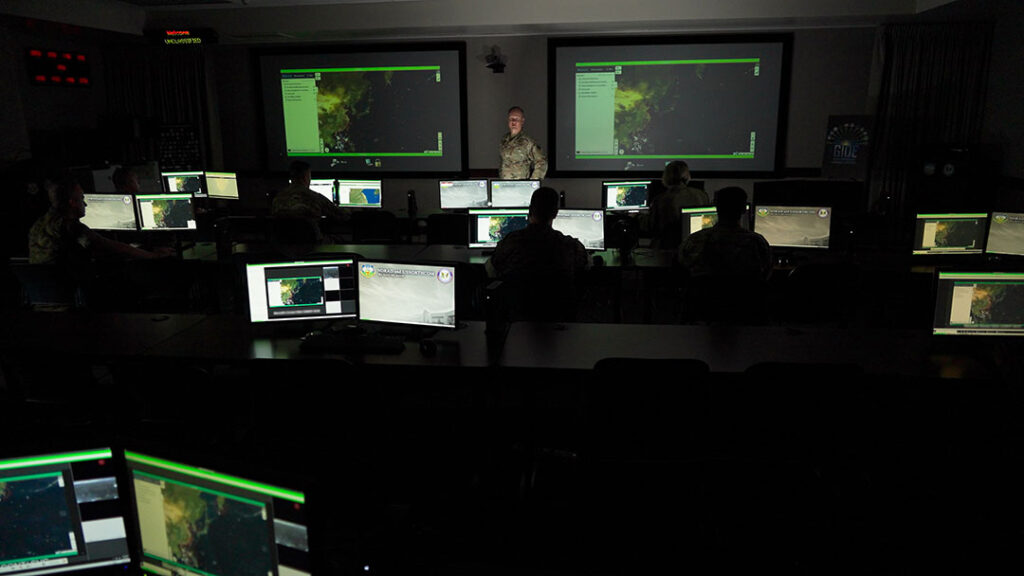THE WATCH STAFF
The latest in a series of cross-command experiments tapping into the potency of artificial intelligence (AI) and machine learning to drive proactive decision-making proved another “leap forward” in integrated deterrence, according to theUnited States commander responsible for homeland defense of North America.
The third Global Information Dominance Experiment (GIDE 3), held July 8-15, 2021, was a collaboration among U.S. Northern Command (USNORTHCOM), North American Aerospace Defense Command (NORAD) and all 11 U.S. combatant commands, as well the U.S. Air Force’s Chief Architect Office and the U.S. Defense Department’s Joint Artificial Intelligence Center (JAIC).
“By integrating more information from a global network of sensors and sources, using the power of AI and machine-learning techniques to identify the important trends within the data, and making both current and predictive information available to commanders, NORAD and USNORTHCOM are giving leaders around the globe more time to make decisions and choose the best options available, whether in competition, crisis or conflict,” U.S. Air Force Gen. Glen D. VanHerck, commander of USNORTHCOM and NORAD, said in a statement.
The experiment was conducted in three synchronized stages, according to USNORTHCOM. The first focused on cost-effective data solutions for delivering rapid indications and warnings; the second highlighted global collaboration to quickly develop deterrence options and logistics planning in contested environments; and the third spotlighted the JAIC’s Matchmaker capability for machine-enabled crisis deterrence and conflict defense options, with real-world military assets responding to simulated threats. (Pictured: United States and Canadian service members participate in the third Global Information Dominance Experiment at the headquarters of U.S. Northern Command and North American Aerospace Defense Command at Peterson Air Force Base, Colorado, in July 2021.)
VanHerck said that GIDE 3 “showcased how the software tools designed for cross-combatant command collaboration, assessment and decision-making can be used to enable more effective global logistics coordination, intelligence sharing and operations planning.”
The ongoing series, which includes experiments in December 2020 and March 2021, complements the U.S. Defense Department’s “shift in focus from pure defeat mechanisms toward earlier deter and deny actions,” according to USNORTHCOM.
“The ability to see days in advance creates decision space,” VanHerck told reporters during a July 28 briefing on GIDE 3. That, in turn, gives combatant commanders “deterrence options in day-to-day competition, de-escalation options in crisis and, if we have to fight, defeat options in conflict.”
In conjunction with GIDE 3, the U.S. Air Force’s Chief Architect Office conducted its fifth Architecture Demonstration and Evaluation to test emerging software and technology, including commercial systems, to sharpen communications, collaboration and threat tracking. “Our nearly two-year experimentation partnership with NORAD and U.S. Northern Command on three of our five events has yielded tremendous progress in designing and evaluating the technical architectures that enable our joint warfighters,” Preston Dunlap, chief architect of the U.S. Air and Space Forces, said in a statement.
U.S. defense leaders say the reimagining of the nation’s deterrence capabilities is vital, given the fast-developing challenges posed by the People’s Republic of China and Russia.
“Right now, the threats we face and the pace of change in the geostrategic environment continue to advance at really alarming rates,” VanHerck told reporters, according to a U.S. Defense Department transcript. “We’ve entered an era of new and renewed strategic competition, and this time, we’re facing two peer competitors, both nuclear-armed, that are competing against us on a daily basis.”
Integrated deterrence is the cornerstone of the nation’s defense, U.S. Defense Secretary Lloyd Austin said recently, and provides “the right mix of technology, operational concepts and capabilities — all woven together and networked in a way that is so credible, flexible and so formidable that it will give any adversary pause.”
“We need to create advantages for us and dilemmas for them,” Austin said.
IMAGE CREDIT: TECH. SGT. TOMMY GRIMES/U.S. AIR FORCE

